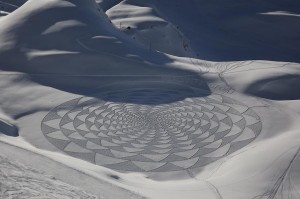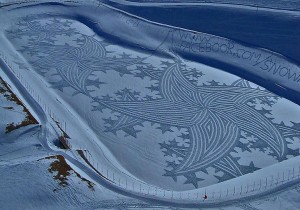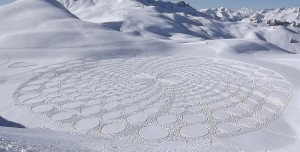 Before you read any more of this post, take a breath…prepare yourself for awesomeness…then go take a look at Simon Beck’s Snow Art Facebook page. Then come back here. We’ll wait.
Before you read any more of this post, take a breath…prepare yourself for awesomeness…then go take a look at Simon Beck’s Snow Art Facebook page. Then come back here. We’ll wait.
OK, that was great, right? Great because it is unexpectedly cool. And because it is so simple you can’t understand why someone hasn’t done it already—except that it is so much work and so transitory, and so noncommercial, that it takes a true artistic sensibility to think of it, and take on the hard work, and then let it disappear under the next snowstorm or the inevitable coming of spring.
At first we suspected that this was all Photoshopped. Could be, but we don’t think so. Mostly, we think he’s genuine because he’s explained that he started making these designs because he had to stop running because his feet hurt. If you were going to fake this, you’d be doing it for attention, and then you wouldn’t complain about your aching feet. That’s Psychology 101.
(In case you skipped Beck’s FAQ, a few details: The initial design is laid out using a “handheld orienteering compass and distance determination using pace counting or measuring tape. Curves are either judged or arcs of circle using a clothes line attached to an anchor at the centre.” Each design takes around 10 hours to complete. Also, he’s an Oxford-educated map maker.)
It’s odd that more people haven’t piled on the Simon Beck train. The Facebook page for his art has just over 14,000 “Likes,” which is the Internet equivalent of anonymity. There’s no Youtube video of Beck traipsing through the snow. (UPDATE: There’s at least one, 830 views as of this writing; meanwhile the “Lord of the Finger Dance” has 6,800 and virtually any stupid cat video—even this one—gets over 50,000.)
Comparisons are odious, especially in matters of art and beauty, but we can’t help comparing these environmental works to those of, say, Christo, who wants to hang silvery panels over five miles of a Colorado river. That’s kind of interesting, but Beck’s work seems more so. The designs appeal to our inner math geek (Mandelbrot! Von Koch!) and we’re touched by the image of a solitary figure carving his work into the soft, transitory pillow of a frozen valley. He deserves our appreciation and encouragement.
Right the wrong. “Like” Simon Beck.











